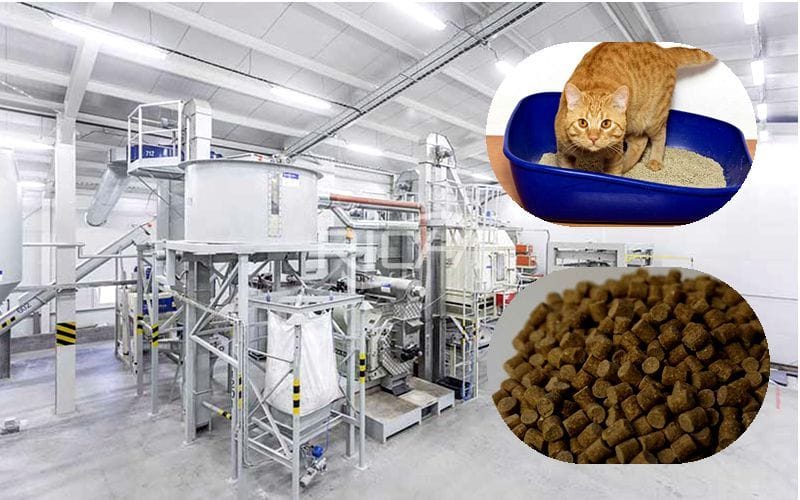
Cat litter is an indispensable part of every cat owner’s routine, but have you ever wondered what goes into making it? The process of manufacturing cat litter involves a combination of science, engineering, and innovation to ensure it performs effectively.cat litter factory From selecting the raw materials to the final product in your cat’s litter box, here’s a look at how cat litter is made and what makes it so effective at absorbing moisture and controlling odors.
Step 1: Choosing the Right Materials
The first step in making cat litter is selecting the right materials. While many cat litters are made from bentonite clay—a naturally occurring substance known for its clumping abilities—there are now a variety of alternatives available. Silica gel, recycled paper, and even plant-based materials like corn or wheat are used in eco-friendly litters. Each material is chosen for its ability to absorb moisture, reduce odor, and provide comfort for cats while being easy for pet owners to use.
Step 2: Mining or Sourcing Raw Materials
For clay-based litters, the process begins with mining bentonite clay from natural deposits. Once the clay is extracted from quarries, it is transported to manufacturing plants for further processing. Eco-friendly litters are sourced from renewable resources, such as recycled paper, sawdust, or plant-based materials, and undergo processing to ensure they meet the required standards for absorbency and texture.
Step 3: Grinding and Processing the Materials
Once the raw materials are sourced, they must be ground into the right size. This step is crucial, as the size and texture of the granules affect how well the litter absorbs moisture and clumps. Factories use specialized grinding equipment to create uniform granules that will absorb urine and form solid clumps when wet. The right granule size ensures that the litter works effectively without being too rough or uncomfortable for cats to dig in.
Step 4: Dust Control
Dust control is one of the most important aspects of cat litter production. Dusty litter can cause respiratory irritation for both cats and their owners, which is why manufacturers use dust extraction systems to minimize the amount of fine particles in the final product. This is especially important for clumping cat litter, where the dust can affect both performance and safety. Through advanced filtration and air circulation systems, manufacturers ensure that their litter has minimal dust, making it safer to handle and scoop.
Step 5: Adding Clumping Agents and Odor Control
One of the defining features of many cat litters is their ability to clump when exposed to moisture. This makes cleaning the litter box easier for owners by allowing them to remove waste without replacing all the litter. To achieve this clumping effect, clumping agents are added to the raw materials. These agents bind the particles together when they come into contact with moisture, creating solid, easy-to-scoop clumps.
Odor control is another key feature of high-quality cat litter. Whether it’s through activated charcoal, baking soda, or natural enzymes, manufacturers add ingredients that help neutralize odors. These additives work by trapping odors and absorbing moisture, preventing the litter box from becoming a source of unpleasant smells. Some litters are even enhanced with fragrances to provide a fresh scent, although unscented options are available for cats with sensitivities.
Step 6: Quality Control
Once the litter is processed and enhanced with clumping agents and odor control additives, it undergoes strict quality control tests. Manufacturers test for a variety of factors, including absorbency, clumping strength, dust levels, and odor control. Each batch must meet high standards to ensure consistency and reliability. Some manufacturers even test their litters with real cats to ensure comfort and performance. Only when the litter passes these tests is it approved for packaging.
Step 7: Packaging the Litter
After passing quality checks, the litter is ready for packaging. Packaging is an important part of the manufacturing process, as it ensures the litter remains clean and easy to transport. Litter is usually packaged in bags or boxes, and many brands offer resealable packaging for easy storage. Packaging also ensures that the litter stays fresh and maintains its properties until it reaches the consumer.
Step 8: Distribution and Retail
Once packaged, the litter is ready to be distributed to retailers. It’s sent to pet stores, supermarkets, and online shops where it can be purchased by cat owners. Cat litter comes in a variety of sizes, from small bags for single-cat households to large bulk bags for multi-cat homes. Retailers stock different types of litter to cater to the various needs of cat owners, from clumping clay to eco-friendly alternatives.
Why It Works: The Science Behind Cat Litter
So, what makes cat litter so effective at controlling odors and absorbing moisture? The key lies in the combination of materials and additives used in its production. Clay-based litters, particularly those made from bentonite, are highly absorbent and form tight clumps when exposed to moisture. cat litter factory This makes it easy to scoop waste without replacing all the litter. Other materials, such as silica gel or recycled paper, offer excellent moisture absorption and odor control, but may not clump as effectively as clay-based options.
The added clumping agents and odor-neutralizing additives ensure that the litter performs its job efficiently by trapping moisture and preventing unpleasant smells. Additionally, the dust-free nature of modern litters makes them safer for both pets and owners, as they reduce respiratory irritation.
Conclusion
The process of making cat litter involves careful selection of raw materials, advanced manufacturing techniques, and extensive testing to ensure that it performs effectively. From mining and grinding to clumping and odor control, every step is designed to provide a cleaner, more comfortable experience for both cats and their owners. So the next time you scoop your cat’s litter box, remember the science behind the product and the thoughtful process that went into making it so effective.